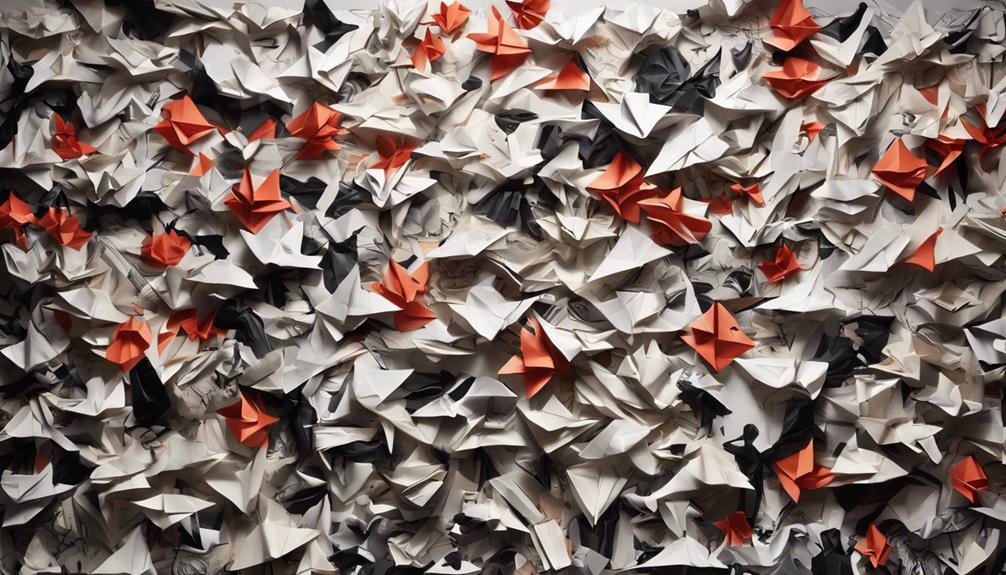In particular, protest artworks are recognized for challenging societal norms and sparking debate. However, some instances have overstepped boundaries, testing the limits of artistic expression and provocation. Examples include the Byzantine Iconoclasm (726-787; 814-842), Suffragette targeting Velázquez's Rokeby Venus (1914), Rauschenberg's erasure of a De Kooning (1953), the vandalism of The Pieta with a hammer (1972), and the Mona Lisa being spray-painted on tour (1974). Particularly, in 1996, an art student infamously vomited on masterpieces. Dollar Sign on Malevich Abstraction (1997), Chinese artists recreating Tracey Emin's 'My Bed' (1999), and the Taliban's destruction of the Bamiyan Buddhas (2001) further exemplify controversial protest artworks.
Key Takeaways
- Vandalism of iconic artworks like the Mona Lisa and Night Watch sparked outrage.
- Destruction of religious icons during Byzantine Iconoclasm challenged societal norms.
- Suffragette's attack on the Rokeby Venus highlighted art as a tool for activism.
- Erasure of a De Kooning piece by Rauschenberg pushed boundaries of art creation.
- Damage to the Pietà and Guernica raised concerns on mental health and art activism limits.
The Byzantine Iconoclasm (726-787; 814-842)
During the Byzantine Iconoclasm of 726-787 and 814-842, Emperor Leo III the Isaurian issued edicts to destroy religious icons. This period marked a significant turning point in Byzantine history, as the empire saw a deliberate effort to eradicate religious imagery from various forms of art.
The Iconoclasm, driven by a desire to consolidate power and establish theological purity, led to the destruction of many artworks depicting religious figures, including mosaics and sculptures. Successive emperors continued these measures, resulting in widespread damage to cultural and religious artifacts.
The Iconoclasm created division within the Byzantine Empire, with tensions running high between iconoclasts and iconophiles who revered religious icons. This tumultuous period not only altered the artistic landscape of the empire but also had lasting implications on religious practices and beliefs.
The legacy of the Byzantine Iconoclasm serves as a reminder of the complex interplay between art, politics, and religion in shaping historical events.
Suffragette Targets Velázquez's Rokeby Venus (1914)
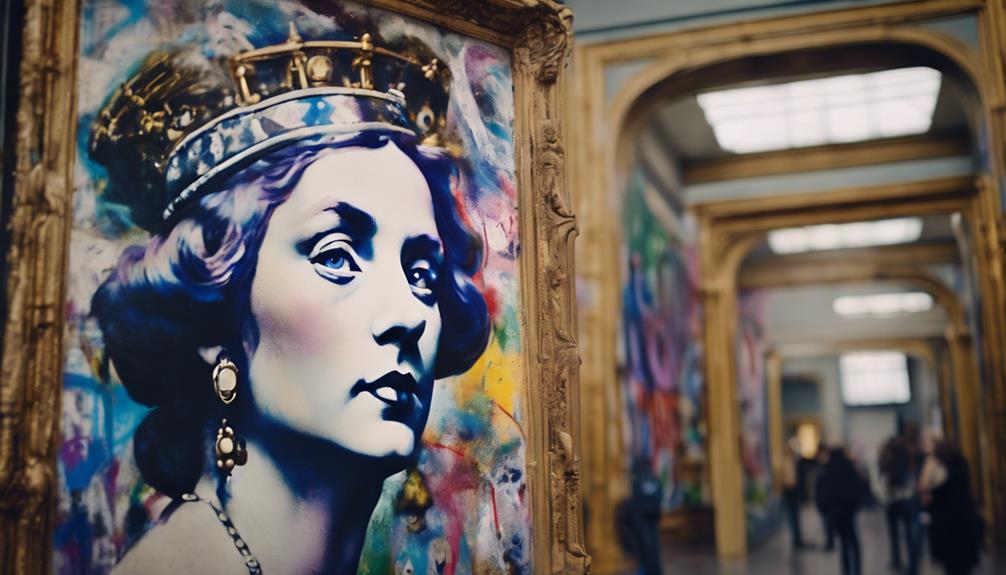
The suffragette movement made a bold statement in 1914 when Mary Richardson targeted Velázquez's Rokeby Venus with a slashing attack. This act was part of the suffragist movement's strategy to use vandalism as a form of protest for women's rights.
Mary Richardson believed that by destroying the painting, she could bring attention to the cause of women's suffrage and the need for gender equality in society. The attack on Velázquez's Rokeby Venus sparked debates on the ethics of using art vandalism as a means of political activism, highlighting the intersection of art, activism, and women's rights in the early 20th century.
- Mary Richardson's targeting of Velázquez's Rokeby Venus was a deliberate and calculated act aimed at drawing attention to the suffragette cause.
- The suffragette movement viewed art vandalism as a powerful tool to amplify their message and provoke societal change.
- Richardson's actions raised important questions about the boundaries of protest and the role of art in advocating for social justice.
Rauschenberg Erases a De Kooning (1953)
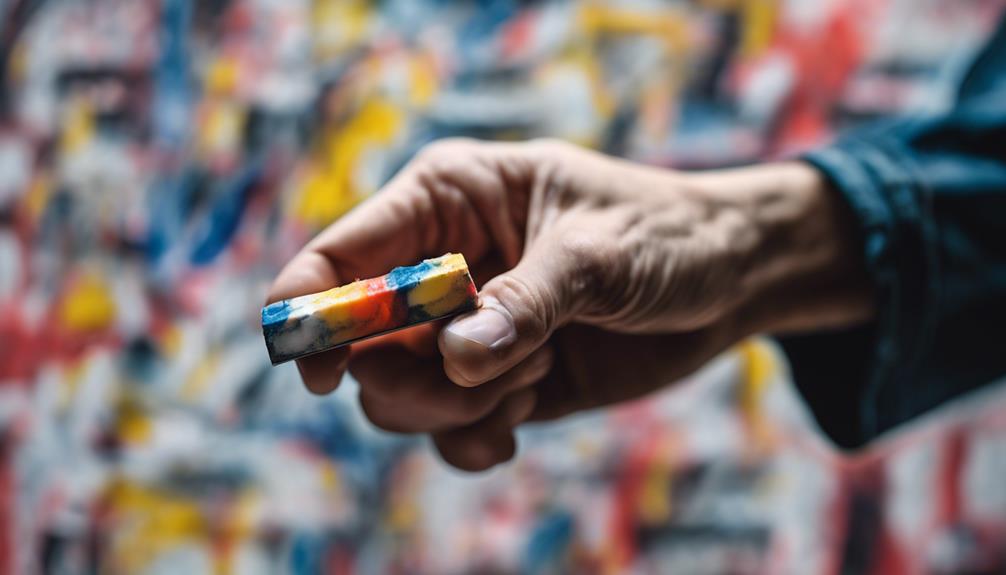
Robert Rauschenberg's erasure of Willem de Kooning's drawing in 1953 stirred debate over whether it was an artistic statement or an act of vandalism.
The impact of this bold move reverberated through the art world, challenging conventional ideas of authorship and boundaries.
Ethical considerations about the erasure's implications on art's value and the artist's role were raised, sparking discussions that continue to resonate in contemporary art discourse.
Artistic Statement or Vandalism?
Erasing Willem de Kooning's drawing in 1953, Robert Rauschenberg sparked debates on the nature of art. Some viewed Rauschenberg's act as a bold artistic statement challenging traditional norms, while others condemned it as vandalism crossing the boundaries of art.
Here are three key points to mull over:
- Artistic Statement: Rauschenberg's erasure of de Kooning's drawing was intended to make a profound statement about the nature of art itself. By removing the work of another renowned artist, Rauschenberg questioned the traditional notions of authorship, ownership, and the value of artistic creation.
- Vandalism: Critics of Rauschenberg's action labeled it as vandalism, arguing that destroying a piece of art, even with artistic intent, was a disrespectful act that undermined the value and integrity of de Kooning's original work.
- Boundaries of Art: The erasure of de Kooning's drawing forced viewers to confront the boundaries of art, pushing them to reconsider what constitutes art and how far artists can go in challenging established conventions. Rauschenberg's controversial act continues to prompt discussions on the limits of artistic expression and the role of destruction in the creative process.
Impact on Art World
Rauschenberg's erasure of de Kooning's drawing in 1953 left a lasting impact on the art world, challenging traditional notions of authorship and sparking debates on artistic boundaries.
By erasing a significant work by de Kooning, Rauschenberg made a bold protest against established norms, questioning the very essence of art creation. This act of erasure wasn't merely an act of vandalism but a deliberate statement that pushed the boundaries of what art could be.
The erased de Kooning piece became a symbol of defiance and controversy, drawing attention to the power of artistic gestures to provoke thought and challenge the status quo. Rauschenberg's bold move forced the art world to reconsider the value and permanence of artworks, igniting discussions that continue to resonate in contemporary art discourse.
This protest artwork demonstrated the transformative impact that art can have in challenging perceptions and reshaping artistic conventions.
Ethical Considerations Raised
The erasure of Willem de Kooning's drawing by artist Robert Rauschenberg in 1953 stirred ethical debates within the art world.
Three key ethical considerations raised by Rauschenberg's act of erasing a fellow artist's work include:
- Destruction of Art: Rauschenberg's erasure of de Kooning's drawing challenged the conventional idea of art preservation, prompting discussions on whether destroying an artwork could itself be considered a form of artistic expression.
- Ethical Considerations: The deliberate erasure of a renowned artist's work raised questions about the ethical implications of altering or obliterating someone else's creation, questioning the boundaries of artistic freedom and respect for the original artist's intentions.
- Artist's Work: The erasure also brought to the forefront debates about authorship and the value attributed to an artist's work, challenging traditional notions of ownership and creativity in the art world.
The Pietà Hit With a Hammer (1972)

An assailant caused significant damage to Michelangelo's 'The Pietà' in 1972 by attacking it with a hammer in St. Peter's Basilica. The hammer-wielding individual targeted the sculpture's face and arm, leading to substantial harm.
It was later revealed that the attacker, believed to be mentally disturbed, was swiftly apprehended by alert bystanders and subsequently placed under institutional care. The aftermath necessitated an extensive restoration process lasting several months, requiring intricate reconstruction of the impacted sections to restore the artwork's integrity.
This distressing event prompted discussions on the importance of mental health care and raised concerns about the security measures within art institutions. The incident not only highlighted the vulnerability of priceless artworks to such acts but also underscored the significance of addressing mental health challenges within society.
The lasting impact of this incident serves as a poignant reminder of the intersection between art, mental well-being, and the need for enhanced security protocols in safeguarding cultural treasures.
Mona Lisa Spray-Painted on Tour (1974)

During a tour in 1974, the Mona Lisa encountered an act of vandalism through spray-painting, leading to damage and heightened security measures. The incident sparked concern over the vulnerability of iconic artworks to such attacks.
- The spray-painting of the Mona Lisa in 1974 shocked the art world, highlighting the risks faced by famous pieces during public exhibitions.
- Security protocols were notably enhanced following this vandalism, with increased surveillance and protective measures deployed to safeguard valuable artworks.
- The swift apprehension of the individual responsible for the spray-painting incident underscored the severity of such offenses and the importance of maintaining strict security around renowned artworks.
The spray-painting of the Mona Lisa serves as a stark reminder of the challenges faced by priceless artworks during public displays, prompting museums and galleries to prioritize security measures to prevent future incidents of vandalism.
Art Dealer Protests With Picasso's Guernica (1974)
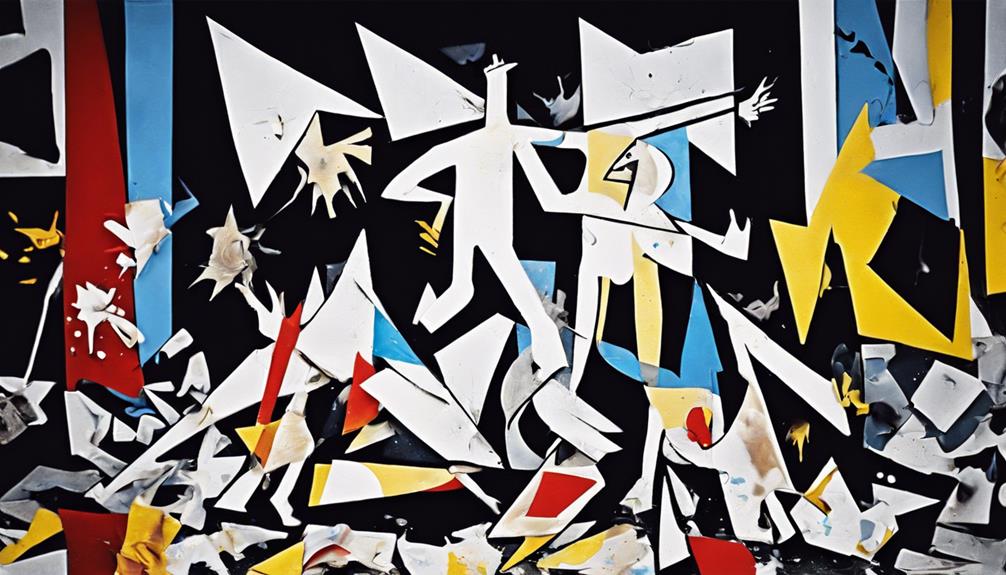
In 1974, an art dealer utilized Picasso's renowned painting Guernica as a potent tool in protesting the Spanish government's policies.
This act not only sparked debates on the intersection of art, politics, and activism but also underscored the significant role of art as a means for social and political commentary.
The use of Guernica in this protest highlighted the enduring impact and power of Picasso's masterpiece as a vehicle for conveying powerful statements.
Picasso's Powerful Statement
Picasso's Guernica made a powerful statement when an art dealer protested by throwing ink at the iconic painting in 1974. This act of protest using one of Picasso's most renowned works sparked significant discussions within the art world.
Here are three key points to ponder:
- Symbolism of Guernica: Guernica, originally created by Picasso in response to the bombing of the Basque town during the Spanish Civil War, is a powerful anti-war symbol. The use of this particular artwork intensified the impact of the protest, emphasizing the message of peace and protest against violence.
- Challenging the Art Market: The protest aimed to draw attention to the frustrations of the art dealer regarding the commercialization of art. By targeting Guernica, the dealer highlighted the tension between art as a form of expression and art as a commodity within the market.
- Debate on Protest Art: This incident ignited debates on the boundaries of protest art and the effectiveness of controversial actions in conveying social or political messages. The protest with Guernica raised questions about the role of art in society and the power it holds in sparking dialogue and change.
Impact of Artivism
Throwing ink at Picasso's Guernica during an auction in 1974, the art dealer made a bold statement against the exploitation of art for profit and political gain. This act of artivism aimed to draw attention to the powerful anti-war message portrayed in the iconic painting.
However, the protest quickly turned into art vandalism, sparking debates on the boundaries of protest within the art world. The incident raised questions about the impact of such extreme actions on political statements and the consequences of damaging significant works of art.
The art dealer, after being swiftly apprehended, faced legal repercussions for defacing the renowned artwork. The event highlighted the fine line between using art as a form of protest and crossing into vandalism, shedding light on the complexities and controversies surrounding artivism.
Ultimately, the protest with Guernica serves as a cautionary tale regarding the consequences of pushing artistic activism to its limits.
Rembrandt's Night Watch Slashed (1975)
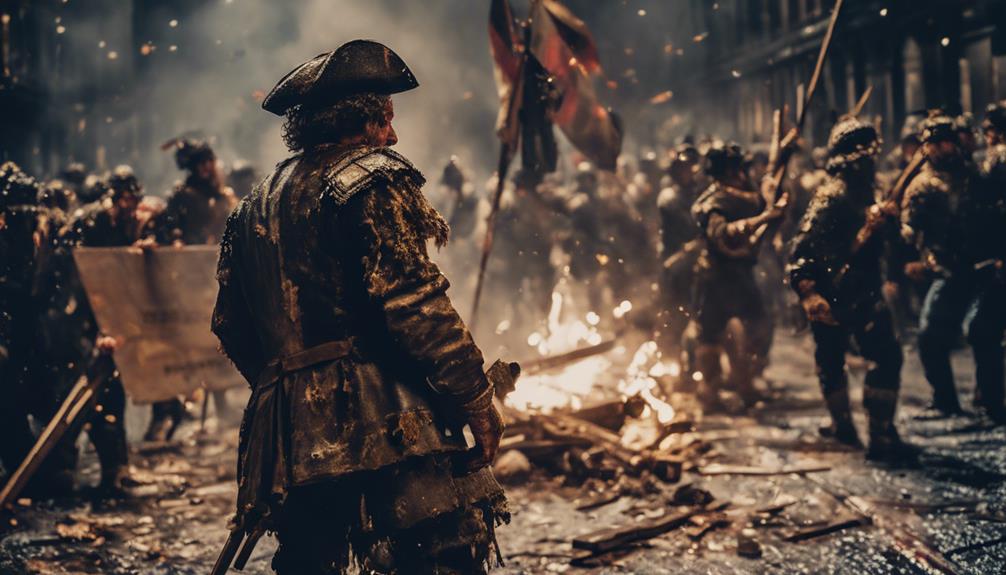
The obscure deity's messenger inflicted significant damage on Rembrandt's Night Watch painting in 1975 by slashing it in Amsterdam. This act of vandalism shocked the art world and raised concerns about the security and preservation of valuable masterpieces in public spaces.
Three key points regarding the slashing of Rembrandt's Night Watch are:
- Targeted Attack: The attacker specifically targeted Rembrandt's Night Watch, a renowned masterpiece, with the intent to cause harm and destruction.
- Divine Mission Claim: The perpetrator claimed to be on a divine mission, adding a mysterious and unsettling aspect to the incident.
- Restoration Efforts: Following the vandalism, extensive restoration efforts were undertaken to repair the slashed sections of the painting, highlighting the importance of preserving cultural heritage and the resilience of the art community in the face of such acts of destruction.
Hammons Whizzes on a Serra Sculpture (1981)

In a provocative challenge to the art world's conventions, artist David Hammons made a bold statement by urinating on a Richard Serra sculpture titled 'T.W.U.' at Leo Castelli Gallery in New York in 1981. Hammons' act was a deliberate attempt to confront the commercialization of art and ignite conversations about race and class within the art sphere. This controversial performance at the renowned gallery sent shockwaves through the art community, questioning the boundaries of artistic expression and the elitism prevalent in the art world.
To emphasize the impact of this event, a comparison between David Hammons and Richard Serra can be made:
| David Hammons | Richard Serra |
|---|---|
| Challenged conventions | Renowned sculptor |
| Provocative statement | Established reputation |
| Critique on art world | Traditional artistic norms |
| Controversial act | Monumental sculptures |
| Sparked debates | Critically acclaimed |
Danaë Splashed With Smelly Liquid (1985)

Mary Beth Edelson, a feminist artist, made a bold statement in 1985 by splashing a mixture of cow dung and urine on the Danaë painting at the Art Institute of Chicago.
The act was a form of protest against patriarchal attitudes in art:
- Edelson intended to challenge the traditional portrayal of women as passive objects for the male gaze.
- The protest aimed to disrupt the prevailing gender representations in art that perpetuated objectification and subordination of women.
The protest sparked discussions on feminist art and gender representation:
- By targeting a classic painting like Danaë, Edelson highlighted the need to reexamine historical artworks through a feminist lens.
- The incident raised questions about the role of art in shaping societal norms and promoting gender equality.
The controversial act was a deliberate attempt to provoke dialogue on power dynamics:
- Edelson's protest sought to confront viewers with the discomfort of confronting entrenched patriarchal norms within the art world.
- The incident emphasized the importance of challenging established conventions to foster inclusivity and diverse perspectives in art.
Hammons' Public Artwork Struck (1989)
Amidst the vibrant streets of Harlem, New York City in 1989, David Hammons' public artwork depicting a basketball hoop faced an unexpected collision with a car. The installation, known as 'Higher Goals', was a part of Hammons' artistic exploration of social and racial issues.
The deliberate act of vandalism on this public artwork was interpreted as a commentary on the struggles experienced by marginalized communities. Hammons, known for his unconventional approach to exploring themes of race, identity, and urban culture, often pushes the boundaries of traditional art forms.
The incident sparked discussions regarding the intersection of protest art and vandalism, raising questions about the impact of such actions on artistic expression. Despite the unexpected turn of events, Hammons' work continues to provoke thought and challenge societal norms through his unique artistic vision, making a lasting impact on the art community in Harlem and beyond.
Duchamp's Urinal Takes the Piss (1993)
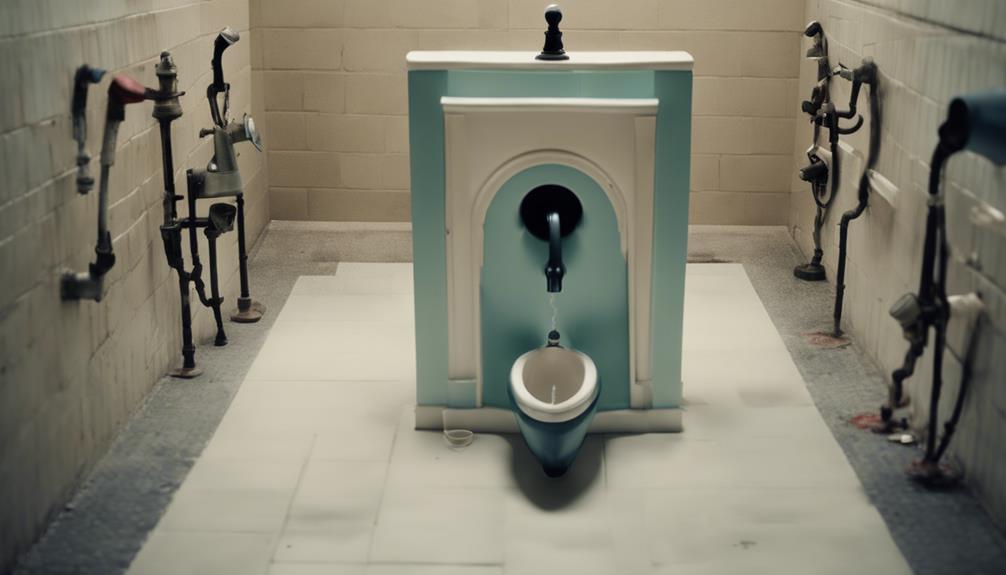
Duchamp's controversial artwork 'Fountain', a urinal displayed as art in 1917, stirred debates challenging traditional notions of artistic value. The piece, created by Marcel Duchamp, sparked controversy due to its unconventional nature and defiance of traditional artistic norms.
Here are three key points to ponder regarding Duchamp's 'Fountain':
- Challenging Conventions: Duchamp's 'Fountain' pushed boundaries by questioning the very definition of art, leading to discussions about what can be viewed as artistic expression.
- Conceptual Impact: The urinal raised profound questions about the role of the artist and the nature of originality in art, influencing the development of conceptual art.
- Critical Reception: While some critics viewed 'Fountain' as a bold and thought-provoking statement, others found it obscene and struggled to accept it as a legitimate artwork.
Duchamp's 'Fountain' remains a controversial and seminal work in the history of art, leaving a lasting impact on the art world's perception of what constitutes art.
Art Student Vomits on Masterpieces (1996)

In 1996, an art student named Marco Evaristti deliberately vomited on masterpieces displayed at a Danish museum, causing a significant uproar in the art world. Evaristti, as a form of protest art, consumed red cabbage soup laced with a potent emetic before regurgitating onto the artworks, titling his controversial performance art piece 'Helena.'
This shocking act ignited debates regarding the boundaries of art and the preservation of cultural heritage, questioning the extent to which artistic expression should be allowed to challenge societal norms. Evaristti's actions were met with legal consequences and widespread public backlash due to the blatant disrespect shown towards the invaluable masterpieces.
The incident serves as a stark reminder of the fine line between artistic expression and vandalism, highlighting the need for artists to approach protest art with sensitivity and respect for the cultural significance of the objects they interact with.
Dollar Sign on Malevich Abstraction (1997)
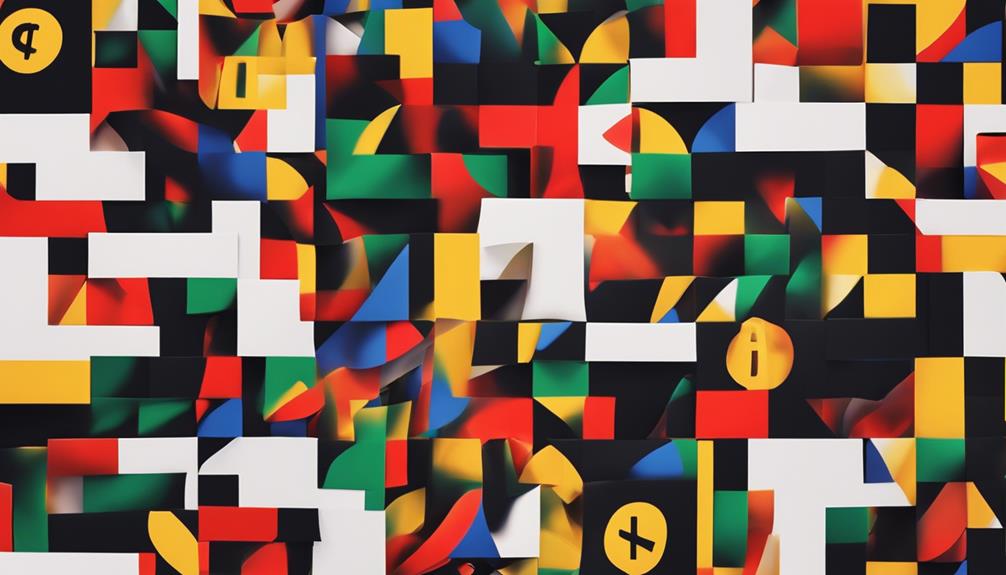
An unknown artist's decision to spray-paint a dollar sign on Kazimir Malevich's Black Square in 1997 sparked controversy within the art community. The defacement of this iconic piece at the Stedelijk Museum in Amsterdam raised questions about the boundaries of artistic expression and the impact of symbolism in protest art.
Critics and enthusiasts alike were divided on whether this act challenged capitalism's influence on art or disrespected a revered masterpiece.
Controversial Symbolism Choice
The controversial protest artwork from 1997 featured a bold dollar sign painted onto a reproduction of Malevich's iconic abstract painting. This choice of symbolism aimed to challenge societal norms and provoke thought on the commercialization of art. The use of the dollar sign sparked debates on the intersection of art, money, and symbolism.
The protest aimed to critique the commercialization of art and challenge societal values associated with wealth and power.
The provocative choice of symbol on the artwork aimed to provoke thought and challenge traditional notions of artistic expression.
This controversial protest artwork highlighted the artist's intention to make a statement on the commodification of art in modern society.
Impact on Art Community
The controversial protest artwork 'Dollar Sign on Malevich Abstraction' by Andrei Molodkin ignited discussions within the art community regarding the impact of commercialization on artistic expression. Molodkin's piece, created in 1997, features a dollar sign painted on a reproduction of Kazimir Malevich's iconic abstract painting, 'Black Square.'
By critiquing the commercialization of art and the influence of money on artistic expression, the artwork challenges viewers to reconsider the value and integrity of art in a capitalist society. The juxtaposition of the dollar sign on Malevich's work sparked debates about the intersection of art, commerce, and social commentary within the art community.
This protest piece raised important questions about how monetary interests may affect the purity and authenticity of artistic creation, prompting artists and critics to reflect on the balance between artistic integrity and financial pressures in the modern art world.
Chinese Artists Jump on Tracey Emin's Bed (1999)

Chinese artists boldly recreated Tracey Emin's controversial artwork 'My Bed' in 1999, sparking intense debates about cultural boundaries and artistic expression.
The Chinese version of the artwork featured a messy bed adorned with condoms, cigarettes, and alcohol bottles, aiming to challenge Western art norms and ignite discussions about cultural differences.
This provocative piece was exhibited in a Beijing gallery, where it triggered heated debates regarding the limits of artistic freedom and the interpretation of cultural symbolism.
The controversial recreation by the Chinese artists was perceived as a daring statement on the dynamics of cultural exchange and the diverse perspectives on artistic representation.
Taliban Destroy the Bamiyan Buddhas (2001)
The Taliban's destruction of the Bamiyan Buddhas in 2001 had a profound impact on cultural heritage. These statues held immense historical significance dating back to the 6th century. Situated in the Bamiyan Valley, a UNESCO World Heritage Site, the Buddhas represented a unique blend of art and history that was irreversibly lost due to the Taliban's actions.
This act of iconoclasm highlighted the clash between differing interpretations of religious beliefs and led to widespread global condemnation of the Taliban's disregard for cultural preservation.
Historical Significance of Buddhas
Destroying the Bamiyan Buddhas in 2001 by the Taliban sparked global outrage due to the statues' historical significance and UNESCO World Heritage status. The Bamiyan Buddhas were monumental ancient statues located in Afghanistan, standing at heights of 53 meters and 35 meters.
These cultural treasures, dating back to the 6th century, were recognized as UNESCO World Heritage sites, representing a significant part of Afghanistan's rich history and religious heritage. The destruction of the Bamiyan Buddhas not only erased physical artifacts but also symbolized a deliberate attack on cultural heritage and religious tolerance, resonating globally and bringing attention to the impact of political ideologies on historical artifacts.
The event served as a stark reminder of the importance of preserving and protecting cultural heritage sites for future generations, highlighting the need for increased awareness and safeguarding of such invaluable treasures.
Impact on Cultural Heritage
Regrettably, the Taliban's destruction of the Bamiyan Buddhas in 2001 had a profound and lasting impact on cultural heritage worldwide. The ancient giant statues, dating back to the 6th century, were significant cultural and religious symbols.
The act of destroying these Buddhas as a form of protest not only erased a tangible piece of history but also highlighted the dangers extremist ideologies pose to heritage sites. The international outrage that followed underscored the need to protect cultural treasures during times of conflict and political unrest.
Efforts to rebuild or restore the Buddhas have been met with challenges due to the extensive damage caused. This tragic event raised important questions about the preservation and safeguarding of cultural heritage, emphasizing the delicate balance between expressing dissent and respecting the rich history that these sites represent.
The legacy of the Bamiyan Buddhas serves as a stark reminder of the irreplaceable loss that can occur when heritage is targeted for destruction in the name of protest.
Frequently Asked Questions
What Famous Painting Was Destroyed by an Activist?
An activist, Mary Richardson, destroyed The Rokeby Venus by Velázquez in 1914 at the National Gallery in London.
Richardson's act of vandalism aimed to protest women's rights as part of the suffragette movement.
The painting was later restored, but the incident remains a notable example of art vandalism for a political cause.
What Is the Most Controversial Form of Art?
The most controversial form of art varies depending on perspective. Some may find performance art pushing boundaries with extreme audience interactions, while others may see provocative conceptual art challenging traditional norms as the most contentious.
Controversy can also stem from political commentary in art, feminist pieces with bold statements, or works that challenge religious sensitivities. Ultimately, what's considered the most controversial form of art is subjective and open to interpretation.
Which Famous Art Works Were Vandalised Recently?
Recently, a group of activists from Just Stop Oil vandalized Van Gogh's 'Sunflowers' at London's National Gallery with tomato soup. They also glued their hands to the wall under the painting.
Despite being arrested, the activists pleaded not guilty to causing damage. District judge Tan Ikram released them on bail with specific conditions.
Charges have been pressed on protestors in the past for similar art vandalism actions.
Which 20TH Century Artwork Was so Controversial That Congress Argued About It?
In the 20th century, the controversial artwork that sparked Congressional debates was Andres Serrano's 'Piss Christ.' This photograph depicted a crucifix submerged in the artist's urine, igniting discussions on art, religion, and freedom of expression.
The contentious nature of 'Piss Christ' led to debates on government funding for provocative art, highlighting the intersection of artistic expression and public sensibilities.
The artwork's controversy underscored the complex dynamics between art, religion, and societal norms.
Conclusion
To sum up, these protest artworks push the boundaries of artistic expression, challenging societal norms and sparking important conversations. While some may view them as going too far, they serve as powerful reminders of the impact art can have on the world.
By pushing the limits of acceptability, these artists force us to confront uncomfortable truths and question our own beliefs. As we continue to navigate the complex landscape of art and activism, it's essential to recognize the profound influence these provocative works can have.
